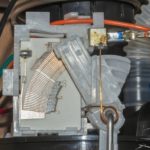
Here’s a terrifying scenario that all drivers fear. You’re speeding along the freeway. Traffic begins to slow ahead of you, and you softly tap the brakes. Nothing happens, much to your dismay! As hard as a plank of wood, the pedal is. To slow the vehicle down, you have to almost stand on the brake. Let’s take a closer look at the causes of intermittent hard brake pedal that occurs from time to time.
In brief, the major reason for a stiff brake pedal is a lack of vacuum pressure, which is why it should be the first thing to check when one is present.
Table of Contents
Causes of Intermittent Hard Brake Pedal
1. Vacuum pressure
Hard brakes are frequently caused by a lack of vacuum in the hose. You may have a good vacuum sometimes and not enough at others when the issue is intermittent. Because this problem is difficult to forecast, it’s worth checking for vacuum in your brake lines the first time you encounter hard braking problems.
The engine in gasoline-powered cars creates a partial vacuum that the brakes’ power booster can use. To work at maximum efficiency, the booster requires 18″ of vacuum. Without the right vacuum pressure, a brake booster will become increasingly difficult to use, until you feel like you’re pushing against a brick wall.
How does this work?
A set of diaphragms within the booster and air on both edges of the diaphragm operate your brake system’s booster. When there is an insufficient vacuum, the diaphragms are unable to propel the pushrod into the master cylinder. Once this occurs, the pedal becomes more difficult to press.
2. Issues with valving
The combination valve, namely the Pressure Differential Valve within that valve, could also be to blame for a hard pedal. This valve is designed for safety reasons, but if it isn’t working properly, it can create problems.
When pressure drops on the front side of the valve against the backside, the Pressure Differential Valve is intended to shift. When this happens, the fluid from the master cylinder reaches a wall. The pedal becomes rock hard since this brake fluid cannot be squeezed. On the good side of the valve, moderate pressure can still be generated, letting the car be driven in a way. A tripped valve is what it’s called.
Because this is not a DIY project, proceed with caution and hire an expert.
3. Pedal ratio
The relationship between the length of your brake pedal and where it pivots is known as the pedal ratio. When drivers face a hard brake, this is an issue that arises frequently.
Most people disregard the pedal ratio as a possible reason for a stiff pedal. When the booster/master is placed under the vehicle, this is less of a problem in later muscle cars and more of a concern in early street rods.
The relationship between the pivot points of the brake pedal and the length of the brake pedal is known as the pedal ratio. Based on the length of the pedal, it is utilized as a lever to provide motion to the booster (or straight to the master cylinder if your automobile does not have a power booster). If this ratio is off by as little as 1/4″, the pushrod will not move far enough to reach the booster. As a result, the booster is unable to move the piston into the master cylinder, resulting in an intermittently harsh brake pedal.
However, sometimes the solution is as simple as repositioning the pushrod’s connecting point between the boosters and the pedal.
4. Wrong/Damaged hoses
In most cases, faulty hoses aren’t something to be concerned about in a vehicle. Carmakers ensure that the proper equipment is used in the right areas, thus it’s uncommon that a new automobile will have the wrong kind of hose.
- Hoses that aren’t compatible
If you buy an old car, conduct your own maintenance, or pay someone who isn’t a professional mechanic to do it for you, you may wind up with a brake vacuum hose that isn’t built for the pressures caused by the brake system.
The car may not have a vacuum hose of any kind, in which case it may not be able to hold the needed pressure or create a real vacuum.
Most brakes require at least 18″ of vacuum to operate effectively, and if there is less vacuum available, performance will begin to deteriorate.
Technically, a faulty or incorrect hose contributes to the same issue I’ve just discussed. If the hose isn’t functioning properly, there won’t be enough suction in the line for the brake booster valve to function effectively.
- Hoses that have been damaged
Even if you have the correct hose your vehicle requires, hose problems can arise with time. Your car’s hoses should be replaced on a regular basis. They might dry up and lose flexibility if not replaced on time.
Temperature variations near your engine might cause hoses to wear out faster, which can be a huge concern for a hose that needs to sustain a vacuum.
If you’re experiencing sporadic hard pedal troubles and haven’t examined your brake lines in a while, now is an excellent time to do so.
Conclusion
All of these are the most typical causes of intermittent hard brake pedal. Intermittent brake hardness is considerably more difficult to manage because you never know when you’ll have a problem with your brakes. This emphasizes the need of having your brakes examined and repaired as quickly as possible.
Hi there! I’m Naomi O’Colman. I’ve got years of experience working at an auto repair shop here in Texas under my belt. On top of that, ever since I was a kid I’ve been passionate about the auto industry. Since I’ve joined the team at automotivegearz.com I’ve been enthusiastically sharing my passion and insights with my readers. I’m dedicated to delivering high quality content and helping you stay up to date with the latest automotive trends and products out there!







